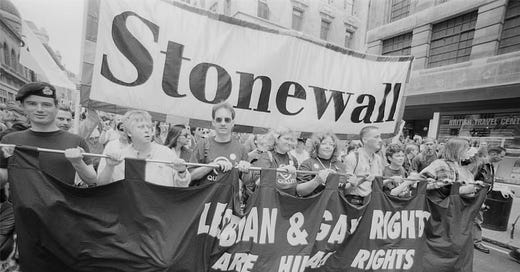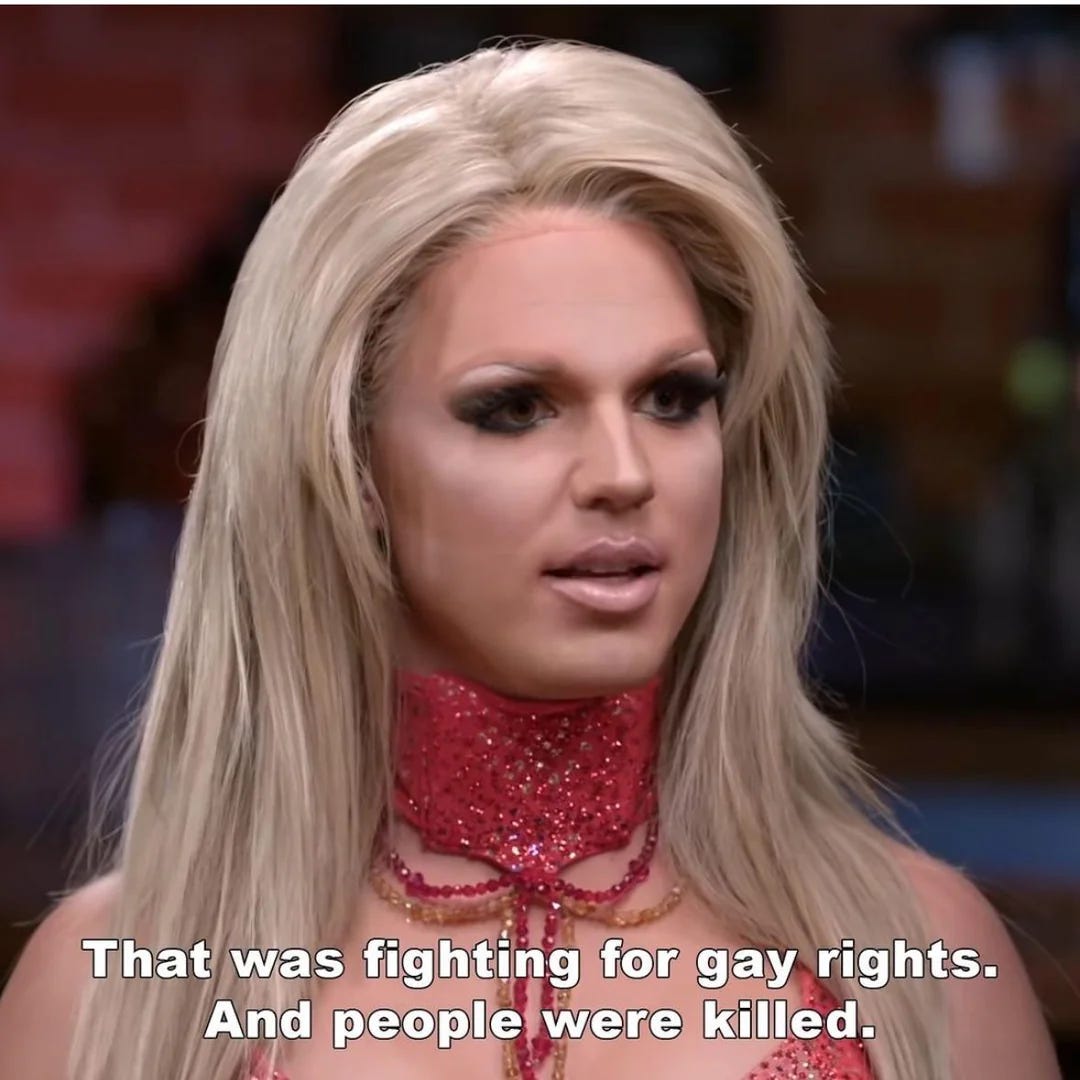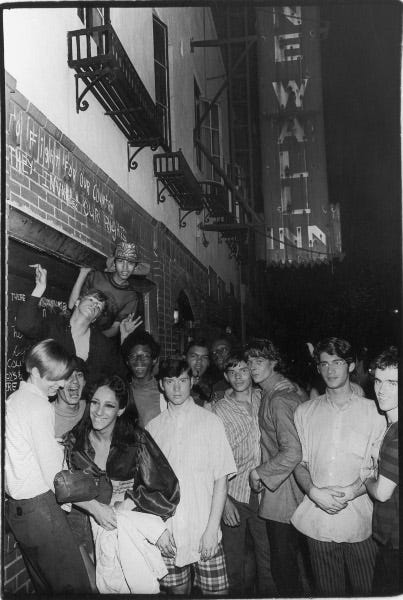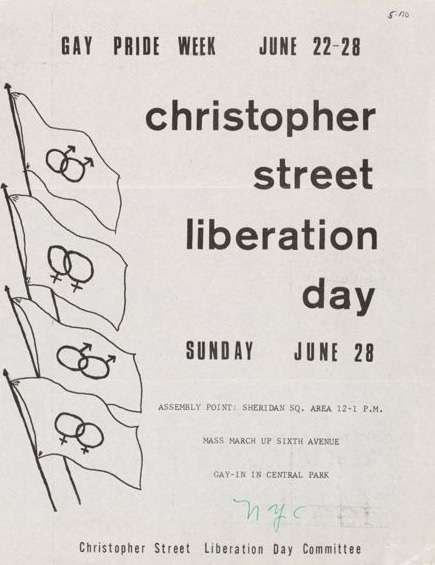nobody was killed at stonewall?
thank you derrick barry for reminding us all to read up on our queer history.
It’s no secret that mainstream media sources have never held space for queer issues. It’s infrequently taught in schools and extremely undervalued in our culture. Queer people are rarely celebrated outside of our community, and any heightened visibility is met with threats of harm.
As time has passed we are at greater risk of forgetting the stories of our queer predecessors. In the present, this risk has actively affected the mindset of queer youth when facing homophobic and transphobic action. We must learn to lean on the memory of those before us, who prevailed despite bigotry and hate.
I’m an older member of Gen-Z, which means I (and many others) attended the Tumblr school for gays in our youth. With supportive resources not always within reach, this was a viable option for queer connection. It helped me form my identity when feeling alienated by my cis-het peers. Although a valuable community for closeted kids, this supplemental history class was filled with misinformation and exhausting rhetoric.
This subculture has since shifted to platforms such as TikTok, Reddit, and X, only to be plagued with similar issues. It stems from the purposeful erasure of queer people and the manipulation of the mainstream media. Controversial takes and bad-faith arguments at the expense of queer people are encouraged and promoted to generate mass interaction. This includes the current administration’s efforts to eradicate trans people, and as a result us young queers still don’t know our history!
This project is named after an infamous altercation between drag race alums Willam Belli and Derrick Barry in a 2017 interview with Billboard magazine. Willam corrects Derrick on her assertion that “people were killed,” at Stonewall, with an immediate and deadpan, “nobody was killed at Stonewall.” Derrick’s statement was ironically made to prove we are losing touch with our history, and in turn, became a viral moment about her own lack of understanding.
I thought this made it fitting to begin with the history of the Stonewall uprising.
Firstly, I want to acknowledge that even statements deemed unequivocally true were formed by collective emotion and many perspectives. With no footage and limited pictures, the larger narrative cannot possibly reflect every experience or be entirely historically accurate. The accepted account has also transformed to align with the gay liberation movement. Sometimes a story that motivates people takes precedence over the truth, and Stonewall has since evolved into a near-mythical origin story of Pride.
So let’s get into it then.
What was Stonewall?
Stonewall was an uprising in June of 1969, in response to repeated police raids on New York gay bars. Many were located on Christopher Street and owned by the mafia who operated without a liquor license. At this time, the New York State Liquor Authority prohibited gay people from being served alcohol. This operated as a pretense for consistent raids and police brutality.
After entering the premises, officers could arrest anyone not wearing at least three articles of “gender-appropriate” clothing based on an obscure and repressive law. The owners were often alerted of the raids prior and were indifferent towards the incidents as they still profited. Despite this mistreatment, these rundown bars served as a safe space for all queers including underaged and unhoused people, drag queens, trans individuals, and people of color.
By the 1960s, the societal repression of homosexuality was forceful and pointed. Mayor Robert F. Wagner, Jr. launched a campaign to rid New York City of gay bars. He was concerned about the city’s image for the 1964 World’s Fair, which only emboldened the actions of police.
This contextualizes the measures taken at the Stonewall uprising. It was the convergence of years of outrage from queer people, particularly trans and gender non-conforming people of color, who were most harshly targeted.
In the early morning of June 28, 1969, police officers raided The Stonewall Inn for the second time that week. Several people were arrested on suspicion of cross-dressing while the remainder of the bar was forced outside. Unlike other nights, the crowd outside did not disperse but rather grew. Frustrations and rising tension gave way to physical forms of protest including taunting and throwing objects. When the police barricaded inside the bar, protestors set the establishment on fire.
Activist and founding member of the Gay Liberation Front, Mark Segal, recalls a “circus of amazing colors and lights and people running. I’m just looking at the door and saying to myself…‘African Americans can fight for their rights, Latinos can fight for their rights, women can fight for their rights, what about us?’”
According to legend, a person brave enough to throw the first brick incited the uproar. However, we are still not sure who it was or if this was how it really happened. The credit is often given to trans icon Marsha P. Johnson with the help of fellow activist, Sylvia Rivera. However, Marsha herself stated she did not arrive until after the fire and chaos had begun, and Rivera by some accounts may have not been present at all. Stormé DeLarverie, a mixed-race butch lesbian, has also long been considered an instigator.
Conflicting accounts from the Stonewall veterans is not unusual. Beyond having varying experiences, some have been known to embellish stories, while other facts have been lost to time. An article in the New York underground newspaper, Rat Subterranean News, entitled “Queen Power” shares the centrality of drag queens in the demonstrations and is considered a more accurate description of events.
The protests continued for six days with varying levels of intensity. Although violence was present on both sides, there is a prevalent misconception that people were killed. The queer community has been under frequent threat of violence both then and now, but there were no fatalities at the Stonewall riots.1 The only associated death was that of a cab driver whose taxi was surrounded on Christopher Street. He died later that night of an apparent heart attack.
Following the events of Stonewall, the bar closed and the space was converted into various businesses throughout the years including a bagel shop, a Chinese restaurant, and a clothing store. In 1987, it became a bar once again with the current management taking over in 2006 under the name, The Stonewall Inn.
The Stonewall riots mark a turning point in the gay rights movement; a catalyst of consciousness surrounding liberation. Although it was in no way the first uprising of its kind, Stonewall’s impact on the greater culture is undeniable. The first Pride parade was held by the Christopher Street Liberation Day Committee on the first anniversary of the rebellion.
In 2016, the Stonewall National Monument was designated by President Barack Obama in recognition of Stonewall’s contributions to queer history. The monument itself is Christopher Park, which sits across from the location of the original Stonewall Inn. The park is also the first and only LGBTQ-related national monument.
Stonewall is often considered the very first layer in understanding queer history— a story for baby gays to cling to when coming out. Instead I think it is important we all remember this pivotal event as it laid the foundation for modern-day Pride. Its legend speaks to the queer community’s anti-police and anti-establishment leanings, and reveals the importance of trans people of color in the liberation movement.
The longer we allow ourselves to disregard this history, the harder it will be to collectivize in the present. We’ve been under attack before, and queer joy has always prevailed. Looking to our veterans for that strength and wisdom is an integral part of queer identity and the reason that the Stonewall legacy will live on.
While some Stonewall veterans insist they were riots, others reject the idea entirely. This Time article explains in detail the power of words and association when igniting a movement. I have chosen to alternate between terms when referring to the event, but it is important to recognize their impact historically.








